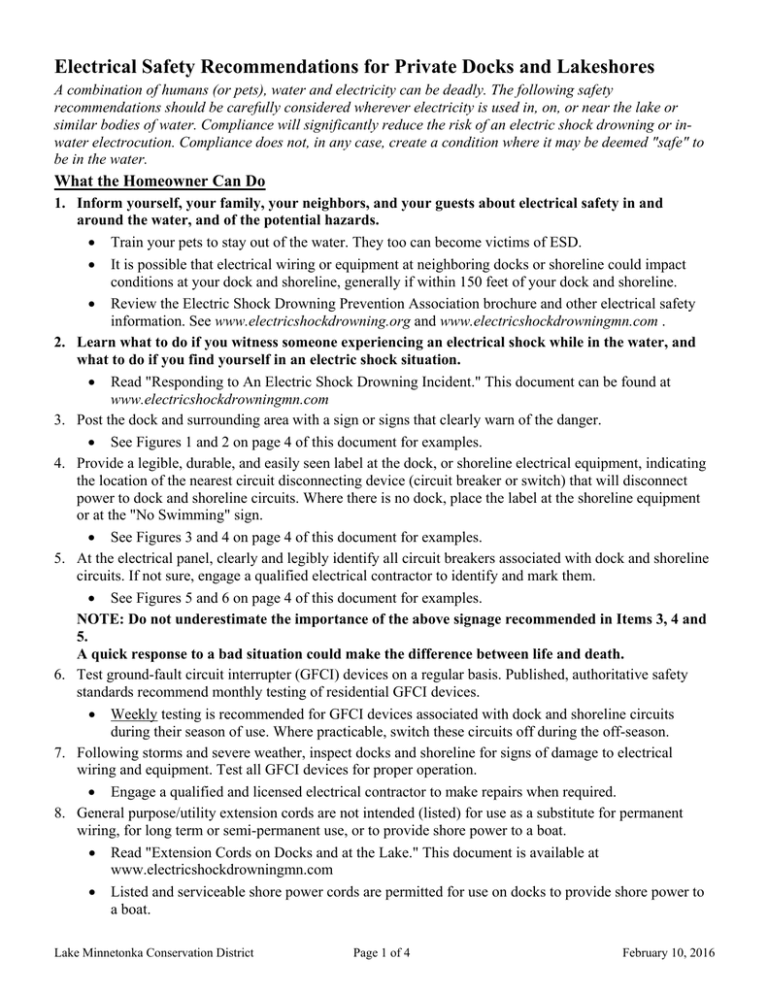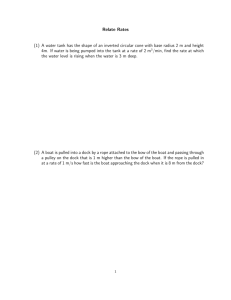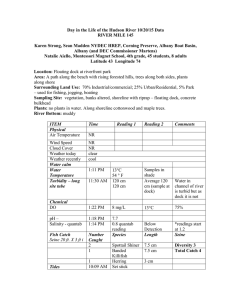Electrical Safety Recommendations for Private Docks and Lakeshores
advertisement

Electrical Safety Recommendations for Private Docks and Lakeshores A combination of humans (or pets), water and electricity can be deadly. The following safety recommendations should be carefully considered wherever electricity is used in, on, or near the lake or similar bodies of water. Compliance will significantly reduce the risk of an electric shock drowning or inwater electrocution. Compliance does not, in any case, create a condition where it may be deemed "safe" to be in the water. What the Homeowner Can Do 1. Inform yourself, your family, your neighbors, and your guests about electrical safety in and around the water, and of the potential hazards. • Train your pets to stay out of the water. They too can become victims of ESD. • It is possible that electrical wiring or equipment at neighboring docks or shoreline could impact conditions at your dock and shoreline, generally if within 150 feet of your dock and shoreline. • Review the Electric Shock Drowning Prevention Association brochure and other electrical safety information. See www.electricshockdrowning.org and www.electricshockdrowningmn.com . 2. Learn what to do if you witness someone experiencing an electrical shock while in the water, and what to do if you find yourself in an electric shock situation. • Read "Responding to An Electric Shock Drowning Incident." This document can be found at www.electricshockdrowningmn.com 3. Post the dock and surrounding area with a sign or signs that clearly warn of the danger. • See Figures 1 and 2 on page 4 of this document for examples. 4. Provide a legible, durable, and easily seen label at the dock, or shoreline electrical equipment, indicating the location of the nearest circuit disconnecting device (circuit breaker or switch) that will disconnect power to dock and shoreline circuits. Where there is no dock, place the label at the shoreline equipment or at the "No Swimming" sign. • See Figures 3 and 4 on page 4 of this document for examples. 5. At the electrical panel, clearly and legibly identify all circuit breakers associated with dock and shoreline circuits. If not sure, engage a qualified electrical contractor to identify and mark them. • See Figures 5 and 6 on page 4 of this document for examples. NOTE: Do not underestimate the importance of the above signage recommended in Items 3, 4 and 5. A quick response to a bad situation could make the difference between life and death. 6. Test ground-fault circuit interrupter (GFCI) devices on a regular basis. Published, authoritative safety standards recommend monthly testing of residential GFCI devices. • Weekly testing is recommended for GFCI devices associated with dock and shoreline circuits during their season of use. Where practicable, switch these circuits off during the off-season. 7. Following storms and severe weather, inspect docks and shoreline for signs of damage to electrical wiring and equipment. Test all GFCI devices for proper operation. • Engage a qualified and licensed electrical contractor to make repairs when required. 8. General purpose/utility extension cords are not intended (listed) for use as a substitute for permanent wiring, for long term or semi-permanent use, or to provide shore power to a boat. • Read "Extension Cords on Docks and at the Lake." This document is available at www.electricshockdrowningmn.com • Listed and serviceable shore power cords are permitted for use on docks to provide shore power to a boat. Lake Minnetonka Conservation District Page 1 of 4 February 10, 2016 What the Homeowner's Electrical Contractor/Electrician Can Do 9. Verify that all circuits providing power to docks and lakeshore equipment are protected by a functional, listed circuit breaker with integral, Class A, ground-fault circuit interrupting (GFCI) capability. • Verify compliance with National Electrical Code (NEC) Articles 553, 555 and/or 682 as applicable. • Furnish and install GFCI circuit breakers for dock and lakeshore circuits and equipment where circuits and equipment are not already so protected. Also see Item 10c. 10. Replace old, worn, damaged and non-functional GFCI circuit breakers. These replacements should always be performed at the earliest possible opportunity. Power to non-protected dock and shoreline circuits should be disconnected until functional replacements are installed. a. Lack of protection would be indicated where the GFCI device fails to trip, and indicate a tripped status, when the TEST button is depressed. b. Instruct homeowners on proper testing of GFCI devices. To ensure that protection remains effective, GFCI circuit breakers and receptacles must be tested (typically by the homeowner) at least once a month. GFCI devices have been known to fail in the "power ON" mode. Testing should be much more frequent where dock and shoreline circuits are concerned. c. Underwriters Laboratories (UL) has revised standard UL943 (Ground-Fault Circuit Interrupters) for 2015 to require that GFCI devices manufactured after June 28, 2015 be self-testing, and remove power when the device is no longer providing the required (and expected) protection. These selftesting circuit breakers are strongly recommended as the need for repeated manual testing is eliminated. [ see http://ecmweb.com/news/nema-and-ul-announce-revisions-ul-943-gfci-standard ] 11. Electrically bond (connect) all metal dock frames, metal dock posts and metal dock hardware (ladders, boat lift frames, etc.) to each other and to the electrical grounding system. • All direct metal-to-metal contact between dock parts should be clean, paint-free, and connected together in a secure manner. 12. If possible and practicable, install a clearly identified, outdoor-rated, electrical disconnect switch (enclosure with integral switch or circuit breaker) near the dock or lakeshore equipment, but not closer to the shoreline high water mark than permitted by the NEC. This will permit the ready disconnection of power by rescuers or bystanders in the case of an emergency. This is an especially important consideration where the dock or lakeshore is a significant distance from the main electrical panel. The ability to quickly disconnect electrical power is cannot be overstated. Additional Considerations that Can Reduce the Electrical Hazard • • Consider use of solar-powered systems and equipment for dock lighting, battery charging, boat lift power, etc. These low voltage, direct current systems and equipment do not have the potential to create an ESD hazard. Consider use of low voltage LED lighting systems and equipment on docks and near the lakeshore. This equipment must comply with all applicable requirements of the NEC, including Article 411, and be listed for use near, on or in water. Power supplies must be of the isolating transformer type and must be listed for use with these circuits. Important Note • Some of the recommendations included herein are mandatory requirements of the NEC. The electrical contractor and electrician will be familiar with and can explain those requirements. Lake Minnetonka Conservation District Page 2 of 4 February 10, 2016 Minnesota Electrical Licensing and Inspection Requirements for Homeowners and for Electrical Contractors/Electricians • ALL electrical installations, including those on private docks, are required by Minnesota law to be in compliance with all applicable requirements of the National Electrical Code (the "NEC"). MN Stat §326B.35 • • Your electrical contractor and electricians must be well versed in and understand all of the NEC requirements applicable to this type of work. These contractors and electricians will be thoroughly familiar with the requirements of Articles 553, 555, 680 and 682, among others. Homeowners are permitted by law to perform electrical work on property that they own and occupy as a residence. They are not required to hold an electrical license to perform this work. MN Stat §326B.31, Subd. 17; Subd. 23; and Subd. 27. MN Stat §326B.33, Subd. 21 (f) • • Please read the following paragraph before opting to perform your own electrical work. It is strongly recommended that qualified, licensed electrical contractors perform all electrical work, especially on docks and near the lakeshore. The great majority of homeowners do not have a grasp of safety rules associated with work on electrical systems; do not know or understand the applicable electrical systems or the applicable requirements of the National Electrical Code, and the applicable requirements of the Minnesota Laws and Rules Related to Electrical Licensing and Inspection. Please! … Leave this electrical work to trained and qualified professionals! ALL electrical installations, alterations and repairs (except for minor repairs) require the filing of a Request for Inspection (a "permit") with, and subsequent inspection by, the appropriate electrical inspection authority (the Authority Having Jurisdiction). This includes work performed by unlicensed homeowners that legally perform electrical work at their residence as permitted by law. MN Stat §326B.36, Subd. 1; Subd. 6; City ordinances are applicable in certain municipal jurisdictions Electrical Inspections performed by the State of Minnesota Cities of Excelsior, Minnetonka Beach, Orono, Shorewood, Tonka Bay, Victoria, and Wayzata. Electrical Inspections performed by the Local Municipality Cities of Deephaven, Greenwood, Minnetonka, Minnetrista, Mound, Spring Park, and Woodland. Lake Minnetonka Conservation District Page 3 of 4 February 10, 2016 Figures 1 and 2: Examples of signs for use at dock and shoreline (left) and on lake side of dock (right): PADDLEBOARDERS / KAYAKERS DO NOT APPROACH DOCK OR SHORELINE ELECTRIC POWER IN USE RISK OF ELECTRIC SHOCK NO SWIMMING OR WADING DO NOT ENTER THE WATER ELECTRIC POWER IN USE RISK OF ELECTRIC SHOCK Figures 3 and 4: Examples of labels for use at dock (left) / shoreline (right): DOCK POWER SAFETY DISCONNECT LOCATED IN GARAGE ELECTRICAL PANEL SHORELINE POWER SAFETY DISCONNECT LOCATED IN GARAGE ELECTRICAL PANEL Figures 5 and 6: Examples of labels for panel: DOCK POWER SHORELINE POWER Other documents that are available from the LMCD or from www.electricshockdrowningmn.com: • "Extension Cords at the Lake and on Docks" • "Responding to an ESD Incident" Notes: 1. The 2017 edition of the National Electrical Code (NEC) is being finalized and will be available for review sometime in mid-2016. It will include additional safety requirements that will apply to both public and private dock facilities. 2. The Fire Protection Research Foundation (the research arm of the National Fire Protection Association) is actively working to improve electrical safety around bodies of water. A report titled "Marina Shock Hazard Research Planning Workshop – Proceedings" is the result of a planning workshop conducted in August of 2015. These efforts will no doubt produce additional requirements and recommendations. This document prepared by Ed Lethert, with contributions and support from Gary Hughes, is intended for publication and distribution by the Lake Minnetonka Conservation District, and other concerned parties, as a set of recommendations for minimizing the possibility of injury or death to human beings where electrical equipment and wiring are used in, on, or near the water. These recommendations are based on specific requirements set forth in the 2014 National Electrical Code, recommendations of the Electric Shock Drowning Prevention Association, the Electrical Safety Foundation International (ESFI), the Energy Education Council’s Safe Electricity program, and others. It is neither assured nor implied that compliance with these recommendations will guarantee the existence of a safe water environment. Compliance with these recommendations is intended to minimize the risk for those individuals that enter the water accidently, inadvertently, or without regard for their personal safety. Please contact the Lake Minnetonka Conservation District at 952.745.0789 with questions or comments. DISCLAIMER These materials are for informational purposes only and not for the purpose of providing professional advice or instruction. The information expressed in these materials is not an exhaustive list of precautions. The author and LMCD do not guarantee the accuracy or reliability of the information provided herein. Users of this information are fully responsible for any consequences resulting from their use of the information. Lake Minnetonka Conservation District Page 4 of 4 February 10, 2016

